
|
IROQUOIS is a name that was established early in American history. Its first recorded use was by the French in the early 1600s to name the five tribes (Nations) of North American Native Indians. The five nations were comprised of the Mohawk, Oneida, Onondaga, Cayuga and Seneca nations, the Iroquois were also know as the Haudenosaunee, or the “People of the Longhouse.” The Iroquois League, or “League of Peace and Power,” as it was known, has proven to be a group of people, well organized, hard working, family oriented and peace loving. It is no wonder that the name Iroquois has been associated with various business adventures, such as banks, hotels, books, knives, and firearms. With the introduction of .22 caliber rimfire |
only about 5½ inches long, has a 2¼-inch long round barrel, and a spur (sheath-type) trigger. The overall look was basically a scaled down version of a Remington No. 4 revolver . The reported years of production and number that were manufactured vary with different sources. Karr’s book, Remington Handguns, gives the production dates of 1878 to 1888 with 50,000 produced. Roy Marcot’s book Remington – America’s Oldest Gunmaker gives the production dates of 1879 to 1886, and a production number of about 10,000 revolvers. by JD Hofer Iroquois revolver with smooth (non-fluted) cylinder Flayderman’s Guide give a starting production year of 1879, ending |
| Page 24 | 1st Quarter 2011 |
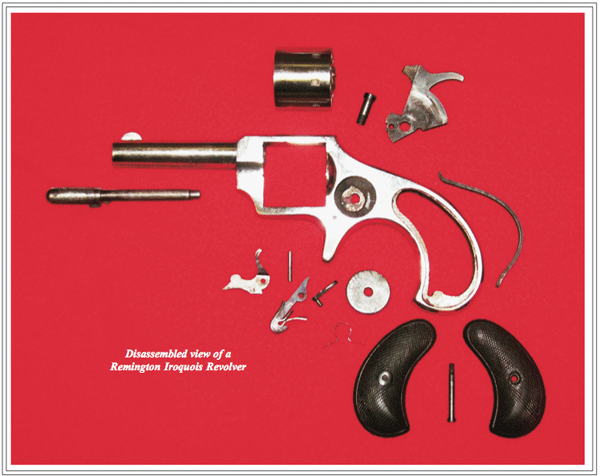
|
.22 caliber revolvers were manufactured. Again at gun shows and auctions, I have found twenty (20) to thirty (30) of these revolvers to every one (1) Iroquois revolver. We also know that Remington produced about a thousand (1,000) Beals 3rd Model Pocket revolvers. It is much easier to find a Beals 3rd Model revolver than an Iroquois revolver. One would infer from this information that there were fewer than five thousand (5,000) Iroquois revolvers produced. This author now believes that this number may be closer to two thousand (2,000) that were produced. This would explain why we do not see Remington Iroquois Revolvers as much as we see .22 caliber revolvers of other manufacturers or have a chance to study and explore them. There are no serial numbers applied to Iroquois revolvers, but there are different variations in this one model. From the ad in the 1883 Remington catalog, one could buy the revolver with a plain cylinder or a fluted cylinder. For extra money you may have the gun engraved, gold gilded, (See revolvers on the cover of this Journal), and your choice of grips (hard rubber, ivory, or pearl). The finish is listed as “full plated”, which has proven to be a nickel plating. A large number of the |
revolvers observed have a blued cylinder pin, hammer and trigger, and a nickel-plated frame. It has been observed that Iroquois revolvers supplied with pearl or ivory grips had a nickel cylinder pin and a blued hammer and trigger. Some of the blued hammers that were observed had the characteristic of “case hardening”, so don’t rule out case hardened hammers. There are rumors that the Iroquois revolver may have been sold with a blued finish. But as of this date, no Iroquois revolver with blued finish has been found. The Iroquois revolver was made without an ejector rod. The round, 2¼”, 5-groove, barrel has no crown on the muzzle, but has a blade (half moon) front sight and a groove in the frame for the rear sight. It has a knurled cylinder pin with a spring-loaded leaf (latch) at the bottom that would engage the frame. The cylinder pin retains the 0.835″ long cylinder which “per your choice” could be plain or fluted. The fluted cylinder model is much rarer than the plain cylinder variation. Maybe the buying public found it hard to pay 50¢ more for the fluted cylinder model. The iron frame is flat-sided with a circular inspection plate on the left side. |
| Page 25 | 1st Quarter 2011 |
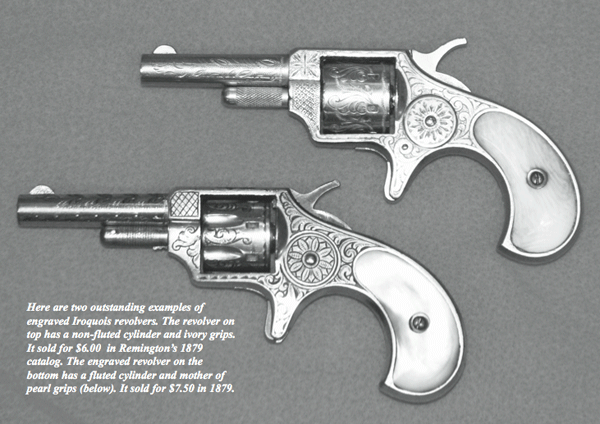
|
The right recoil shield on the frame is slotted and the frame is channeled to allow the passage of a .22 Long rimfire cartridge. The full outside area of the grip frame is recessed to allow the mounting of the grips. The original factory ivory and hard rubber grips were supplied without escutcheons for the grip screw. It is believed that later ivory and all pearl grips were supplied with escutcheons. There is only one screw in the frame. It enters the right side to hold the hammer and exits on the left side to hold the inspection plate. Located under the round inspection plate is the cylinder pawl and the spring for the pawl. One pin in the frame holds the spur trigger and its spring. There is no main spring tension screw. A cylinder-locking bolt is located on the underside of the frame, just ahead of the spur trigger. The Iroquois revolver was made with three different variations of barrel marking. The first two are identical, with IROQUOIS on top of the barrel, and E. REMINGTON & SONS, ILION, N. Y. on the left side of the barrel. The only difference is that one is in large print and the other is of smaller print. The third variation is “no marking” at all on the barrel… |
just a plain, unmarked barrel. The revolver has also been observed with IROQUOIS only on top of the barrel. Yet another variation is to find the barrel marked only on the left side in small print E. REMINGTON & SONS, ILION. N.Y. One Iroquois revolver has been observed with “double stamped” marking on the top and left side of the barrel. As a side note, it has been observed that of all the fluted cylinder models had the small print and were marked on top and left side of the barrel. The Iroquois revolver was sold in a small green cardboard box with a red cardboard top and only one label on the end of the top cover that read IROQUOIS – .22 Cal., with a thin line at the top and bottom of the printing. A rare find is an Iroquois in a wooden walnut case or in a leather covered case. It is not known if the cases were supplied from the factory by Remington, as this availabilty was not mentioned in any Remington catalog. The general thought is that the little guns were put into the cases by dealers to enchance the sale of the revolver. An Iroquois revolver in a box or case is not often encountered. |
| Page 26 | 1st Quarter 2011 |

|
The Remington Iroquois revolver was a well constructed, low priced pocket revolver. So why was the revolver only produced for such a short time? Only five years, according to the catalog records. The price during this time for a plain Iroquois was $2.50. It is noted that most of the Remington competitors, estimated at 45 to 50 manufactures, started selling their revolvers in the years between 1870 and 1871. Remington had an up-hill battle establishing a market for their small, .22 cal. revolver when they started in 1879. During this time Remington was having a cash flow problem and the Remington brothers were searching for ways to cut costs. |
 |
| Page 27 | 1st Quarter 2011 |
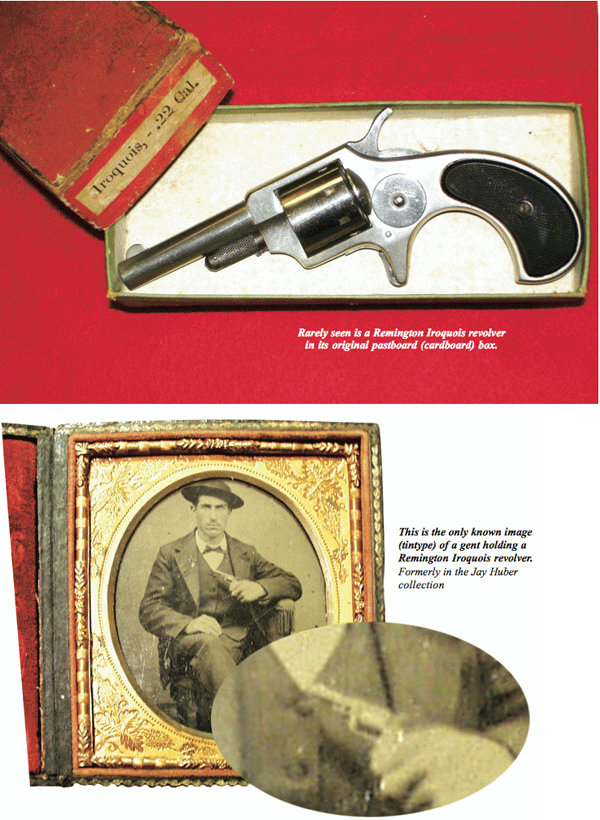
| Page 28 | 1st Quarter 2011 |

| Page 29 | 1st Quarter 2011 |

| Page 30 | 1st Quarter 2011 |
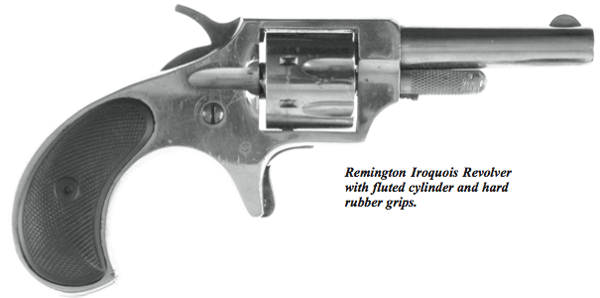
| Like all good enterprising companies, E. Remington & Sons evaluated their marketing of the Iroquois revolver. Its acceptance by the public was not as great as their Smoot revolvers, and certainly could not match the sales of their highly successful rolling block rifles. The last year that Remington had an advertisement for the Iroquois was in the 1883 catalog, as Lamberson, Furman & Company took over the marketing of all Remington sporting arms in that year. It is not known if Remington manufactured any Iroquois revolvers between 1883 and 1886, or they just used up existing inventory. The Lamberson, Furman catalog of 1886 shows a price of $1.90 for a plain, plated Iroquois. But, in the 1887 catalog the price was $2.00 (a reduced price compared to the earlier Remington catalog price of $2.50). At the same time the catalog shows an unidentified small, .22 revolver for $1.50. Again, competition with other manufacturers was tough in the late 1800s. This arrangement with Lamberson, Furman & Co. did little to prevent E. Remington & Sons from entering receivership in 1886, and eventually being sold to Hartley & Graham in June 1888. This ended the sales of Remington’s smallest revolver, the IROQUOIS. |
 |
We, as members of the Remington Society of America, are always eager to share information and knowledge on the Guns of Remington. This article is no exception. If anyone has any additions or correction to the article, or have other information on the IROQUOIS REVOLVER, please contact the author at jh****@*******al.net
|
Acknowledgements I wish to thank the late Jay Huber (a good friend who will be missed) for his help with E. Remington & Sons catalogs, and to Roy Marcot for his untiring help and knowledge. Also, special thanks to Gordon Stanley, Fred Ream, Dick Littlefield and many others for their words of encouragement. Other sources of information came from Roy Marcot’s book Remington – America’s Oldest Gunmaker, Flayderman’s Guide to Antique Guns, Early Cartridge Handguns in .22 Caliber by John S. Laidacker, and Karr’s book, Remington Handguns. |
| Page 31 | 1st Quarter 2011 |

| Page 32 | 1st Quarter 2011 |
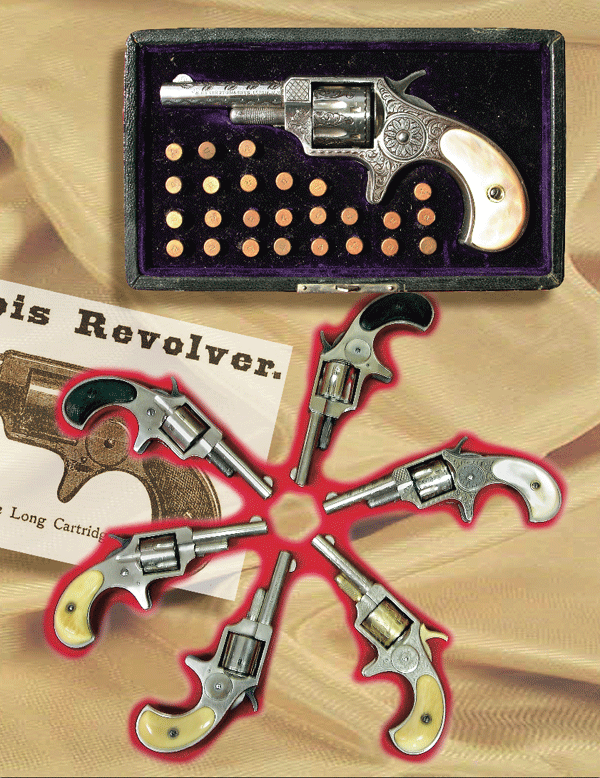
| Page 33 | 1st Quarter 2011 |
|
On-line Search/Sort Journal Index |
On-line Journal Articles
|
